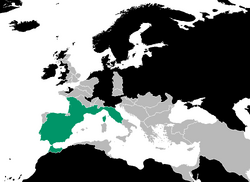| Visigothic Empire | |||||
| |||||
The Visigothic Kingdom, c.1320. | |||||
| Capital | Toulouse (until 1233) Tarragona (1233 - 1358) Toletum (1358 - 1443) | ||||
| Languages | Latin, Gothic | ||||
| Religion | Christianity (Ephesusian, Eborian, Judeo), Manichaeism and Roman Pagan | ||||
| Government | Monarchy | ||||
| Emperors | |||||
| - | 1150 - 1184 | Ricimer I (first) | |||
| - | 1435 - 1443 | Augustacer (last) | |||
| Historical era | Early Medieval | ||||
| - | Migration Period | c.1100s | |||
| - | Visigothic Expansion | 1224 - 1229 | |||
| - | Battle of Antium | 1261 | |||
| - | Conquest of Gaul | 1326 | |||
| - | Fall of Toletum | 1443 | |||
The Visigothic Empire (Latin: Wisigotharum regnum) was a Gothic empire that spanned Western Europe following the fall of the Roman Empire and the Kingdom of Italy from the 12th to 15th centuries.
One of the many successor states of the Roman Empire during the early-medieval period, it was the strongest and most stable of all, its rulers (many of whom titled themselves Augustus) conquering swaths of land throughout Western Europe in an attempt to restore the Roman Empire.At its height under Ricimer III, it spanned from Mauritania into the Iberian peninsula, throughout Eastern Gaul, and North Italy, including Rome.
Furthermore, due to the adoption of Christianity by the Visigoths in the early 11th century, the empire became the first major Christian state of Europe, the establishment of the Ephesusian sect of the faith as the state religion under Ricimer II ultimately initiating a period of the religions growth to prominance across the continent.
Ultimately, generals and officials within the empire split it apart after a rapid fifty year declination of power, the last emperor, Augustacer, being killed during the Fall of Toletum at the age of 18, local rulers, warlords and magisters rising to fill the power vaccumm and establish their own dominance in Europe.

